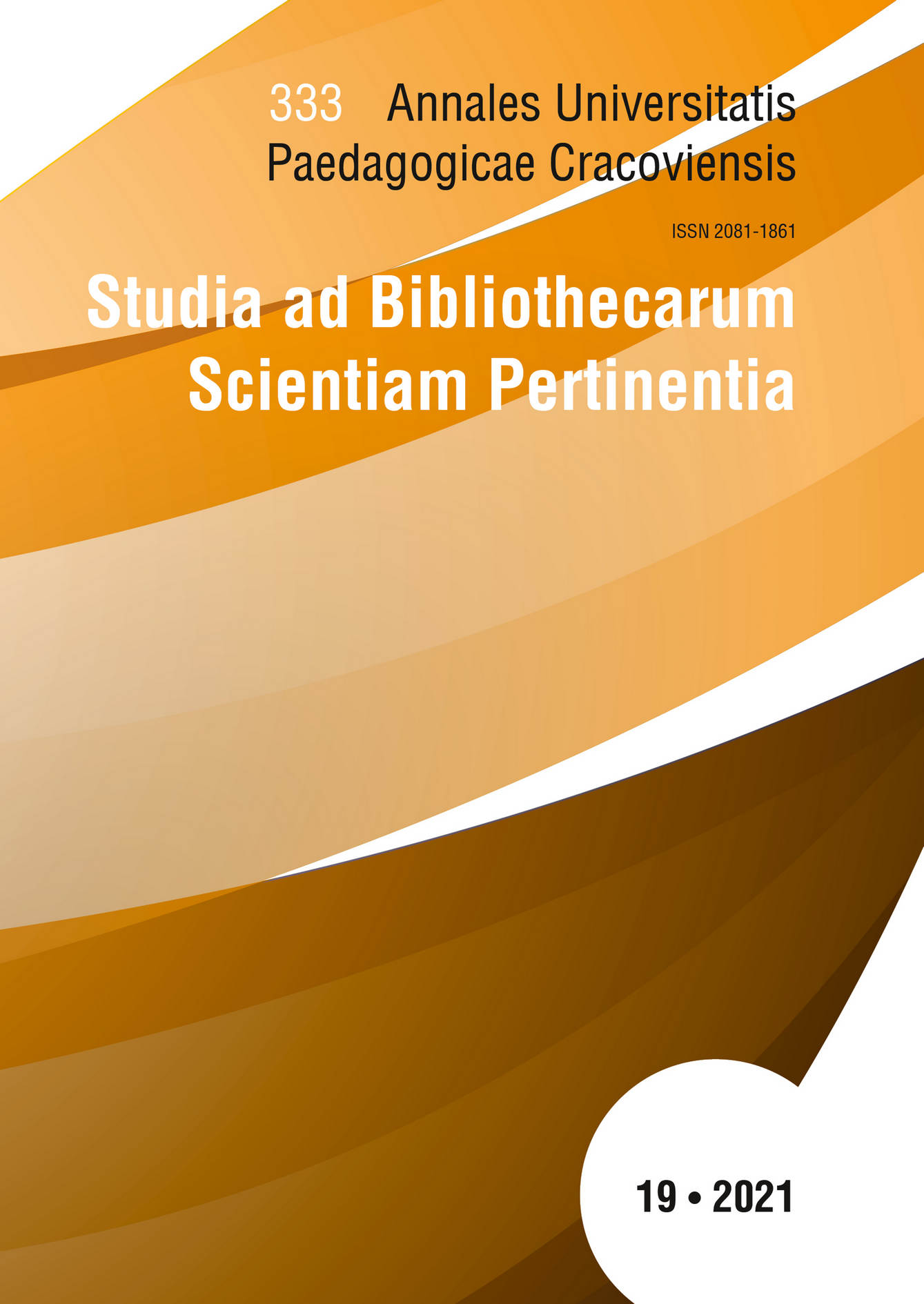Film as a Tool for Transferring Information in the Literature of the 20th Century
DOI:
https://doi.org/10.24917/20811861.19.33Keywords:
information, affordances, literature, film conventions, intersubjective codesAbstract
The authors of this article discuss the many different ways in which writer can use the literary affordances of film. Writers present diverse approach to intersubjective codes of cinema, according to the authors, while extremes emerged in literary genres. Moreover, the author’s claim, the attitude writers take to film works and means of expression of the film can be radically different. Authorial approaches range from being fascinated with film methods of presenting reality (Tadeusz Peiper) and using them as a way to stimulate the reader's imagination (Stephen King), to ignoring such methods, regarding them as extremely conventionalized or even trivial (Zbigniew Herbert) and therefore not worthy of interest. The 460 works of ten authors were analysed to find the contexts in which the words film and movie appear. The authors found that Tadeusz Peiper was fascinated by silent films while Zbigniew Herbert, who evaluated them from perspective of time, condemned their conventions. Making references to film assisted Andrzej Stasiuk in presenting local community, and it helped Stephen King gaining global fame. Prominent playwriters either ignored affordances of film in their literary works (e.g. Samuel Beckett and Tom Stoppard) or affordances were key in their dramas: e.g. Tennessee Williams, who used numerous cinematic references to portray his characters; intersubjective communication codes made Williams’s plays popular.
References
Branigan E., Schemat fabularny, przeł. J. Ostaszewski, [w:] Kognitywna teoria filmu. Antologia przekładów, red. J. Ostaszewski, Kraków 1999, s. 112–154.
Casanova P., The World Republic of Letters, trans. M. B. DeBevoise, Harvard 2007.
Challis J., The Knowledge. A Collection of Poetry and the Poem Noir: Film Noir in Contemporary Poetry, Newcastle University, Newcastle 2015, [on-line:] https://theses.ncl.ac.uk/jspui/bitstream/10443/3072/1/Challis%2c%20J%202015.pdf – 18.06.2021.
Florczyk M., W roli: (on sam). Kreacje Marcina Świetlickiego, [w:] Literatura i kino. Polska po 1989 roku, red. P. Marecki, A. Pilarska, K. Puto, Kraków 2013, s. 69–82.
Gibson J. J., The Theory of Affordances, [in:] Perceiving, Acting, and Knowing: Toward an Ecological Psychology, eds. R. Shaw, J. Bransford, New Jersey 1977.
Goldstein L., The American Poet at the Movies: A Critical History, Ann Arbor 1995.
I Found It at the Movies: An Anthology of Film Poems, ed. R. R Pierson, Toronto 2014.
Ikony, pseudoherosi i zwykli śmiertelnicy. Antologia najnowszego dramatu polskiego, red. E. Manthey, K. Paprocka, P. Grzymisławski, Warszawa 2015.
Jacobs A. M., Neurocognitive Poetics: Methods and Models for Investigating the Neuronal and Cognitive-affective Bases of Literature Reception, „Frontiers in Human Neuroscience” 2015, no. 9, [on-line:] https://www.frontiersin.org/articles/10.3389/fnhum.2015.00186/full [Dodaj do projektu Citavi wg DOI] – 18.06.2021.
Jazownik L., Jazownik M., Formy obecności filmu w literaturze fikcjonalnej, [w:] Ze srebrnego ekranu na papier. Ślady sztuki filmowej w literaturze, red. D. Kulczycka, Zielona Góra 2019, s. 39–68.
Kaczanowski A., Matriarchat, „Wizje” 2018, nr 1, [on-line:] http://magazynwizje.pl/adam-kaczanowski-matriarchat – 18.06.2021.
Koschany R., Chaplin jako Charlie, „Kwartalnik Filmowy” 2002, t. 23, nr 37–38(97–98), s. 82–90.
Kulczycka D., Film w prozie Jakuba Żulczyka, Zielona Góra 2020.
Kulczycka D., Filmowość literackiej konstrukcji świata przedstawionego w powieści kryminalnej „Komisarz Bordelli. Morderca, którego nie było” Marca Vichiego, „Forum Poetyki” 2021, nr 23, s. 190–209.
Kuziak M., Prowincja – centrum. Strategie mocy i słabości literatury peryferyjnej (Mickiewicz – Gombrowicz – Stasiuk), „Rocznik Komparatystyczny” 2015, nr 6, s. 139–157.
McCabe S., Cinematic Modernism: Modernist Poetry and Film, Cambridge 2005.
Mondo James Dean: A Collection and Stories and Poems about James Dean, eds. R. Peabody, L. Ebersole, New York 1996.
Mondo Marilyn: An Anthology of Fiction and Poetry, eds. R. Peabody, L. Ebersole, New York 1995.
Movieworks: Stories and Poems Movies, ed. J. W. Blanpied, Rochester, NY 1990.
Niewinni kaznodzieje. Filmowy zestaw wierszy poetów polskich urodzonych w latach 1958–1985, red. D. Foks, Warszawa–Skierniewice 2001.
Otto W., Literatura i film w kulturze polskiej dwudziestolecia międzywojennego, Poznań 2007.
Otto W., O filmowości literatury, „Forum Poetyki” 2021, nr 23, s. 6–29.
Pisula R., Powrót człowieka za sześć milionów dolarów, „Art Papier”, 1.10.2013, [on-line:] http://artpapier.com/index.php?page=artykul&wydanie=185&artykul=3968 – 18.06.2021.
Prusinowski P., Filmowość literackiego cyberpunku na przykładzie powieści „Neuromancer” Williama Gibsona, „Forum Poetyki” 2021, nr 23, s. 161–173.
Rayner K., Pollatsek A., Ashby J., Clifton Ch. Jr., Psychology of Reading, New York 2012.
Sartori G., Homo videns. Telewizja i postmyślenie, przeł. J. Uszyński, Warszawa 2007.
Schmidt U., Interwencje polityczne Herberta w latach III RP, przeł. J. Dąbrowski, „Odra” 2017, nr 10, s. 52–55.
Ślósarz A., Dwa bieguny filmowych afordancji w literaturze XXI w., [w:] Ze srebrnego ekranu na papier. Ślady sztuki filmowej w literaturze, red. D. Kulczycka, Zielona Góra 2019, s. 21¬–38.
The Faber Book of Movie Verse, eds. P. French, K. Wlaschin, London 1993.
The Picture Dancing on a Screen: Poetry of the Cinema: An Anthology, ed. A. Slide, New York 1988.
Zawrót głowy. Antologia polskich wierszy filmowych, oprac. D. Foks, Łódź 2018.
Стихи про кино, Poemata.ru – стихи и поэмы, 2018, [on-line:] https://poemata.ru/poems/cinema – 18.06.2021.
Cтихи пpo кино, „РуCтих. Cтихи классиков”, [on-line:] https://rustih.ru/stixi-pro-kino/ – 18.06.2021.
Downloads
Published
How to Cite
Issue
Section
License
Copyright (c) 2021 AUPC Studia ad Bibliothecarum Scientiam Pertinentia

This work is licensed under a Creative Commons Attribution 4.0 International License.

